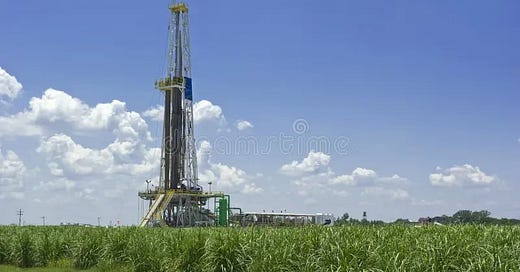USGS Confirms Major Oil & Gas Reserves Beneath Acadiana: What It Means for Louisiana’s Future
By The Bayou Insider Staff
Published: May 8, 2025
A massive new report from the U.S. Geological Survey (USGS) confirms what many in Louisiana’s energy sector have long suspected: Acadiana is sitting atop one of the nation’s richest untapped reserves of natural gas and oil.
The assessment, which focused on the Hosston and Travis Peak formations, estimates that 35.8 trillion cubic feet (TCF) of technically recoverable natural gas and 28 million barrels of oil lie beneath Louisiana and its Gulf Coast neighbors. For Acadiana, this discovery isn’t just a geological footnote—it could be an economic game-changer.
A Deep Discovery Beneath Our Feet
The formations in question—Hosston and Travis Peak—span a narrow subsurface corridor stretching from southeastern Texas across central Louisiana and into the Mississippi Delta. These deep formations have long been known to hold hydrocarbons, but this updated assessment confirms their vast potential.
With 35.8 TCF of natural gas, this find represents roughly 14 months of total U.S. natural gas consumption, placing Louisiana at the forefront of national energy discussions. The 28 million barrels of oil, while smaller by comparison, still add significant value to the equation.
Acadiana in the Spotlight
Acadiana sits directly over some of the richest sections of these formations. The economic implications for the region are substantial: new jobs, expanded operations for oilfield services, increased local tax revenue, and a broader boost to related industries.
While no official estimates have been given yet on job creation, local economic developers and industry leaders are already expressing optimism. Louisiana’s deep roots in the oil and gas sector mean that companies and workers are well-positioned to take advantage of any uptick in exploration and production.
Fueling the Nation—Again
Natural gas has become a cornerstone of the U.S. energy mix, especially as cleaner-burning alternatives to coal are prioritized. The USGS’s findings reinforce Louisiana’s critical role in powering America—both literally and figuratively.
This discovery doesn’t just benefit Acadiana; it strengthens the entire Gulf Coast’s strategic position in energy production, with ripple effects across transportation, manufacturing, and national energy independence efforts.
A State Built for This Moment
What sets Louisiana apart is its ready-made infrastructure. The state boasts an extensive network of pipelines, refineries, LNG terminals, and ports. This means the transition from assessment to extraction can happen faster here than in many other regions.
For communities across Acadiana, that readiness could translate into immediate economic development—provided the right balance between regulation, innovation, and environmental responsibility is struck.
The Environmental Equation
Louisiana is no stranger to the costs of energy extraction. Coastal erosion, land subsidence, and habitat disruption have historically followed unchecked development. Many environmental experts caution that this new opportunity must not come at the expense of already fragile ecosystems.
According to studies from Louisiana’s Department of Natural Resources, past drilling has contributed to subsidence in several parts of the state. Coastal protection advocates will no doubt be watching closely as development plans unfold.
The challenge: maximize economic impact while preserving the natural beauty and resilience of Acadiana’s coastline.
BOEM’s Report Adds Context
This USGS assessment isn’t the only recent energy headline. The Bureau of Ocean Energy Management (BOEM) also released its 2024 report, estimating 0.97 billion barrels of undiscovered oil and over 40 TCF of natural gas in state waters off the Louisiana coast.
Together, these reports present a powerful narrative: Louisiana remains one of the most energy-rich states in the nation, onshore and off.
What Comes Next?
Industry watchers expect exploration companies to ramp up activity in the coming months, though much will depend on state and federal permitting timelines. Public hearings, landowner negotiations, and environmental reviews are likely to dominate the headlines as the process begins.
Lawmakers in Baton Rouge are also expected to weigh in, especially as debates continue over balancing energy development with environmental oversight and landowner rights.
For now, Acadiana finds itself at the center of a high-stakes opportunity—one that could shape the region’s economy for generations.
Conclusion: A Defining Moment for Louisiana
This discovery underscores what many Louisianans already know: our land is rich—not just in culture and heritage, but in resources. As the state moves to responsibly harness these new reserves, it must do so with wisdom, vision, and respect for both people and place.
Whether this becomes a boom or a bust depends on how carefully we proceed. But one thing is certain—Louisiana is once again on the map, and the eyes of the energy world are watching.
Stay Connected with The Bayou Insider
For more updates on Louisiana’s economy, energy developments, and political news, be sure to follow us on Substack and share this article with your network. Like, comment, and let us know how this story impacts your community.
Sources:
U.S. Geological Survey – USGS Releases Assessment of Undiscovered Oil and Gas Resources in the Hosston and Travis Peak Formations
U.S. Geological Survey – Fact Sheet FS2025–3021
Bureau of Ocean Energy Management – Eighth Biennial Report to Congress
Louisiana Department of Natural Resources – Subsidence from Oil and Gas Production in Louisiana
U.S. Geological Survey – Induced Subsidence Related to Hydrocarbon Production
U.S. Energy Information Administration – Louisiana State Energy Profile
BP’s First LNG Shipment from Calcasieu Pass Marks a New Era in Louisiana’s Energy Landscape
By The Bayou Insider Staff





